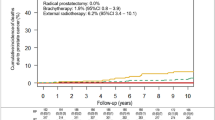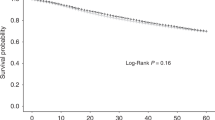Abstract
Background:
Radiotherapy is the most common curative cancer therapy used for elderly patients with localized prostate cancer. However, the effectiveness of this approach has not been established. The purpose of this study is to evaluate the long-term outcomes of primary radiotherapy compared with conservative management in order to facilitate treatment decisions.
Method:
This population-based study consisted of 57 749 patients with T1–T2 prostate cancers diagnosed during 1992–2007. We utilized an instrumental variable (IV) analytical approach with competing risk models to evaluate the outcomes of primary radiotherapy vs conservative management. The IV was comprised of combined health service areas with high- and low-use areas corresponding to the top and bottom tertile in radiotherapy usage rates.
Results:
In patients with low-/intermediate-risk prostate cancer, 10-year prostate cancer-specific and overall survival was similar in high- and low-radiotherapy use areas (96.1 vs 95.4% and 56.6 vs 56.3%, respectively). In patients with high-risk disease, however, areas with high-radiotherapy use had a higher 10-year cancer-specific survival (90.2 vs 88.1%, difference 2.1%; 95% CI 0.3–4.0%) and 10-year overall survival (53.3 vs 50.2%, difference 3.1%; 95% CI 1.3–6.3%). Results were similar irrespective of the type of radiotherapy used. To assess the robustness of our choice of IV, we repeated the IV analytical approach using different IVs (using the median utilization rate as the cutoff) and found the results to be similar.
Conclusions:
Among men >65 years of age, the benefit of primary radiotherapy for localized disease is largely confined to patients with high-risk prostate cancer (Gleason scores 7–10).
This is a preview of subscription content, access via your institution
Access options
Subscribe to this journal
Receive 4 print issues and online access
$259.00 per year
only $64.75 per issue
Buy this article
- Purchase on Springer Link
- Instant access to full article PDF
Prices may be subject to local taxes which are calculated during checkout


Similar content being viewed by others
References
Howlader N, Noone AM, Krapcho M, Garshell J, Miller D, Altekruse SF et al SEER Cancer Statistics Review, 1975-2011. National Cancer Institute: Bethesda, MD, 2014.
Shao YH, Demissie K, Shih W, Mehta AR, Stein MN, Roberts CB et al. Contemporary risk profile of prostate cancer in the United States. J Natl Cancer Inst 2009; 101: 1280–1283.
NCCN Clinical Practice Guidelines in Oncology: Prostate Cancer Version 1. 2013. http://www.nccn.org/professionals/physician_gls/f_guidelines.asp#prostate. Accessed on 10 January 2014.
Bill-Axelson A, Holmberg L, Filen F, Ruutu M, Garmo H, Busch C et al. Radical prostatectomy versus watchful waiting in localized prostate cancer: the Scandinavian prostate cancer group-4 randomized trial. J Natl Cancer Inst 2008; 100: 1144–1154.
Bill-Axelson A, Holmberg L, Garmo H, Rider JR, Taari K, Busch C et al. Radical prostatectomy or watchful waiting in early prostate cancer. N Engl J Med 2014; 370: 932–942.
Bill-Axelson A, Holmberg L, Ruutu M, Haggman M, Andersson SO, Bratell S et al. Radical prostatectomy versus watchful waiting in early prostate cancer. N Engl J Med 2005; 352: 1977–1984.
Miller DC, Gruber SB, Hollenbeck BK, Montie JE, Wei JT . Incidence of initial local therapy among men with lower-risk prostate cancer in the United States. J Natl Cancer Inst 2006; 98: 1134–1141.
Lp S, Dvorak T, Yu W, Patel K, Obadan N, Chung M et al Radiation Therapy for Localized Prostate Cancer: An Update. Agency for Healthcare Research and Quality (AHRQ): Rockville, MD, 2010.
Stukel TA, Fisher ES, Wennberg DE, Alter DA, Gottlieb DJ, Vermeulen MJ . Analysis of observational studies in the presence of treatment selection bias: effects of invasive cardiac management on ami survival using propensity score and instrumental variable methods. JAMA 2007; 297: 278–285.
Lu-Yao GL, Albertsen PC, Moore DF, Shih W, Lin Y, DiPaola RS et al. Survival following primary androgen deprivation therapy among men with localized prostate cancer. JAMA 2008; 300: 173–181.
Lu-Yao GL, Albertsen PC, Moore DF, Shih W, Lin Y, DiPaola RS et al. Fifteen-year survival outcomes following primary androgen-deprivation therapy for localized prostate cancer. JAMA Intern Med 2014; 174: 1460–1467.
Zeliadt SB, Potosky AL, Penson DF, Etzioni R . Survival benefit associated with adjuvant androgen deprivation therapy combined with radiotherapy for high- and low-risk patients with nonmetastatic prostate cancer. Int J Radiat Oncol Biol Phys 2006; 66: 395–402.
Roberts CB, Albertsen PC, Shao YH, Moore DF, Mehta AR, Stein MN et al. Patterns and correlates of prostate cancer treatment in older men. Am J Med 2011; 124: 235–243.
Surveillance Epidemiology and End Results (SEER) Program. Public use tape (1973–1990). National Cancer Institute, DCPC, Surveillance Program, Cancer Statistics Branch: Rockville, MD, 1993.
Warren JL, Harlan LC, Fahey A, Virnig BA, Freeman JL, Klabunde CN et al. Utility of the SEER-Medicare data to identify chemotherapy use. Med Care 2002; 40: IV-55–IV-61.
Wong YN, Mitra N, Hudes G, Localio R, Schwartz JS, Wan F et al. Survival associated with treatment vs observation of localized prostate cancer in elderly men. JAMA 2006; 296: 2683–2693.
Shahinian V, Kuo Y, Freeman J, Goodwin J . Risk of fracture after androgen deprivation for prostate cancer. N Engl J Med 2005; 352: 154–164.
Albertsen P . When is a death from prostate cancer not a death from prostate cancer? J Natl Cancer Inst 2000; 92: 590–591.
Klabunde CN, Potosky AL, Legler JM, Warren JL . Development of a comorbidity index using physician claims data. J Clin Epidemiol 2000; 53: 1258–1267.
Makuc D, Haglund B, Ingram D, Kleinman J, Feldman J . Vital and Health Statistics–Health Service Areas for the United States. In: Services USDoHaH (ed). National Center for Health Statistics: Hyattsville, MD, 1991.
Angrist J, Imbens G, Rubin D . Identification of causal effects using instrumental variables. J Am Stat Assoc 1996; 91: 444–455.
Therneau TM, Grambach PM, Pankratz VS . Penalized survival models and frailty. J Comput Graph Stat 2003; 12: 156–175.
R Development Core Team R. A language and environment for statistical computing. R Foundation for Statistical Computing; www.cran.r-project.org; 2012.
Therneau TM, Grambsch PM . Modeling Survival data: extending the Cox Model. Springer: New York, 2000.
Efron B, Tibshirani RJ . An Introduction to the Bootstrap. Chapman & Hall: New York, 1993.
Asbell SO, Martz KL, Pilepich MV, Baerwald HH, Sause WT, Doggett RL et al. Impact of surgical staging in evaluating the radiotherapeutic outcome in RTOG phase III study for A2 and B prostate carcinoma. Int J Radiat Oncol Biol Phys 1989; 17: 945–951.
Wilt TJ, Brawer MK, Jones KM, Barry MJ, Aronson WJ, Fox S et al. Radical prostatectomy versus observation for localized prostate cancer. New Engl J Med 2012; 367: 203–213.
Widmark A, Klepp O, Solberg A, Damber JE, Angelsen A, Fransson P et al. Endocrine treatment, with or without radiotherapy, in locally advanced prostate cancer (SPCG-7/SFUO-3): an open randomised phase III trial. Lancet 2009; 373: 301–308.
Lu-Yao GL, Yao SL . Population-based study of long-term survival in patients with clinically localised prostate cancer. Lancet 1997; 349: 906–910.
D'Amico AV, Chen MH, Renshaw AA, Loffredo M, Kantoff PW . Androgen suppression and radiation vs radiation alone for prostate cancer: a randomized trial. JAMA 2008; 299: 289–295.
NCCN Clinical Practice Guidelines in Oncology. Prostate Cancer. National Comprehensive Cancer Network, 2015.
Albertsen PC, Hanley JA, Penson DF, Barrows G, Fine J . 13-Year outcomes following treatment for clinically localized prostate cancer in a population based cohort. J Urol 2007; 177: 932–936.
Zhou EH, Ellis RJ, Cherullo E, Colussi V, Xu F, Chen WD et al. Radiotherapy and survival in prostate cancer patients: a population-based study. Int J Radiat Oncol Biol Phys 2009; 73: 15–23.
Tewari A, Divine G, Chang P, Shemtov MM, Milowsky M, Nanus D et al. Long-term survival in men with high grade prostate cancer: a comparison between conservative treatment, radiation therapy and radical prostatectomy–a propensity scoring approach. J Urol 2007; 177: 911–915.
Abdollah F, Sun M, Schmitges J, Thuret R, Tian Z, Shariat SF et al. Competing-risks mortality after radiotherapy vs. observation for localized prostate cancer: a population-based study. Int J Radiat Oncol Biol Phys 2012; 84: 95–103.
Wilt TJ, Shamliyan T, Taylor B, MacDonald R, Tacklind J, Rutks I et al Comparative Efffectiveness of Therapies For Clinically Localized Prostate Cancer, Agency for Healthcare Research and Quality: Rockville, MD, 2008.
Resnick MJ, Koyama T, Fan KH, Albertsen PC, Goodman M, Hamilton AS et al. Long-term functional outcomes after treatment for localized prostate cancer. N Engl J Med 2013; 368: 436–445.
Kim S, Moore DF, Shih W, Lin Y, Li H, Shao YH et al. Severe genitourinary toxicity following radiation therapy for prostate cancer–how long does it last? J Urol 2013; 189: 116–121.
Acknowledgements
We acknowledge the efforts of the Applied Research Branch, Division of Cancer Prevention and Population Science, National Cancer Institute, the Office of Information Services and the Office of Strategic Planning, Center for Medicare and Medicaid Services, Information Management Services and the Surveillance, Epidemiology and End Results (SEER) Program tumor registries in the creation of the SEER-Medicare database. This study was approved by the NCI, CMS and Rutgers RBHS IRB. We thank Carolina Lozada and Edith Prescod for their outstanding technical and administrative assistance. The project described was supported by Award number RC1CA145722 from the National Cancer Institute (NCI) and Rutgers Cancer Institute of New Jersey CCSG core grant NCI CA-72720.
Author information
Authors and Affiliations
Corresponding author
Ethics declarations
Competing interests
During the past 5 years, the following authors have received financial support and maintained affiliations as follows: GLL-Y has been a consultant for Merck Research Laboratories. In addition, S-LY has been employed by Schering-Plough, Merck and Sun Pharmaceuticals LLC in the area of clinical research. None of these entities contributed funding, or played any role whatsoever in the design, interpretation or drafting of our study or manuscript.
Additional information
Disclaimer
This study utilizes the Linked SEER-Medicare Database. NCI is not involved in the design or conduct of this study. The content is solely the responsibility of the authors and does not necessarily represent the official view of the National Cancer Institute or the National Institute of Health.
Rights and permissions
About this article
Cite this article
Lu-Yao, G., Kim, S., Moore, D. et al. Primary radiotherapy vs conservative management for localized prostate cancer—a population-based study. Prostate Cancer Prostatic Dis 18, 317–324 (2015). https://doi.org/10.1038/pcan.2015.30
Received:
Revised:
Accepted:
Published:
Issue Date:
DOI: https://doi.org/10.1038/pcan.2015.30



